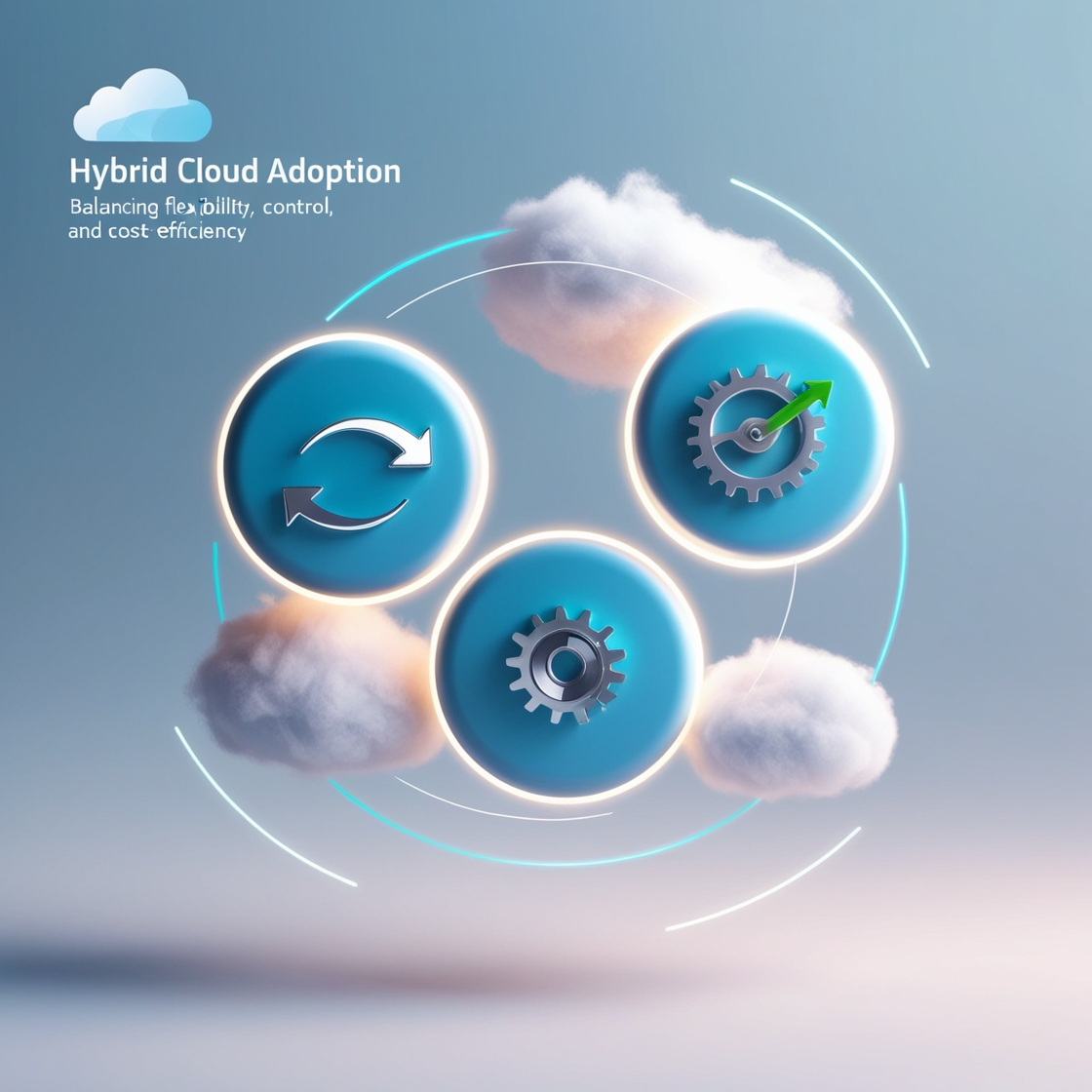
Introduction
In today’s fast-paced digital world, businesses are constantly seeking ways to innovate while maintaining control over their operations and costs. One of the most significant advancements in the realm of IT infrastructure is the hybrid cloud. This model combines the best of both public and private cloud environments, offering a unique blend of flexibility, control, and cost-efficiency that has captured the attention of businesses worldwide. But what exactly is a hybrid cloud, and why are so many organizations adopting it? Let’s dive into this topic and explore the benefits, challenges, and strategies for successful hybrid cloud adoption.
Understanding the Hybrid Cloud Model
Definition and Components
A hybrid cloud is an IT architecture that incorporates elements of both private and public clouds. This model allows organizations to store sensitive data on a private cloud while leveraging the scalability and cost-effectiveness of a public cloud for less critical operations. The key components of a hybrid cloud include on-premises data centers, private cloud infrastructure, and public cloud services, all seamlessly integrated to work together as one unified system.
Private vs. Public Cloud: The Best of Both Worlds
The hybrid cloud model offers the advantages of both private and public clouds. Private clouds provide enhanced security and control, making them ideal for handling sensitive data and critical applications. Public clouds, on the other hand, offer unparalleled scalability and cost savings, making them suitable for workloads that require high availability and flexibility. By combining these two environments, businesses can achieve a perfect balance between security, control, and cost-efficiency.
Key Benefits of Hybrid Cloud Adoption
Flexibility in Resource Management
One of the most significant advantages of adopting a hybrid cloud model is the flexibility it offers in managing resources. Businesses can scale their IT resources up or down based on demand, ensuring they have the necessary capacity to handle peak loads without overprovisioning. This flexibility allows organizations to respond quickly to changing market conditions and customer needs.
Enhanced Control Over Data and Workloads
With a hybrid cloud, businesses have greater control over their data and workloads. Sensitive information can be kept in a private cloud, where it is protected by stringent security measures, while less critical data and applications can be run on a public cloud. This approach allows organizations to maintain compliance with regulatory requirements while taking advantage of the agility and cost savings offered by public cloud services.
Cost Efficiency and Optimization
Hybrid cloud solutions offer significant cost savings by allowing businesses to optimize their resource allocation. Companies can avoid the high upfront costs associated with building and maintaining on-premises infrastructure by leveraging the pay-as-you-go models of public cloud providers. Additionally, by using the public cloud for non-critical workloads, businesses can reduce their overall IT expenses and focus their budget on more strategic initiatives.
Challenges in Adopting Hybrid Cloud
Complexity in Integration
While the hybrid cloud model offers many benefits, it also comes with its share of challenges. One of the most significant is the complexity involved in integrating different cloud environments. Ensuring seamless communication and data flow between private and public clouds requires careful planning and the right tools. Without proper integration, businesses may struggle to achieve the full potential of their hybrid cloud strategy.
Security Concerns and Data Compliance
Security is always a top concern when adopting new technologies, and hybrid cloud is no exception. Organizations must ensure that their data is protected at all times, whether it is stored in a private cloud or transferred to a public cloud. Additionally, businesses must comply with various data protection regulations, which can be challenging in a hybrid environment where data is spread across multiple platforms.
Managing Multiple Cloud Environments
Managing a hybrid cloud environment can be complex, as it involves overseeing multiple cloud platforms and ensuring they work together seamlessly. This requires a high level of expertise and the right set of tools to monitor, manage, and optimize both private and public clouds effectively.
Strategies for Successful Hybrid Cloud Implementation
Assessing Business Needs and Goals
Before implementing a hybrid cloud solution, businesses must assess their needs and goals. This involves evaluating the current IT infrastructure, identifying workloads that can benefit from cloud migration, and understanding the potential impact on operations. By clearly defining their objectives, organizations can develop a tailored hybrid cloud strategy that aligns with their business goals.
Choosing the Right Cloud Providers
Selecting the right cloud providers is crucial for a successful hybrid cloud implementation. Businesses should choose providers that offer robust security features, seamless integration capabilities, and flexible pricing models. It’s also essential to consider the provider’s track record in terms of reliability and customer support.
Developing a Comprehensive Migration Plan
A well-thought-out migration plan is essential for the successful adoption of a hybrid cloud. This plan should outline the steps involved in migrating workloads to the cloud, including data transfer, application reconfiguration, and system testing. It’s also important to establish a timeline for the migration process and allocate resources accordingly.
Flexibility in Hybrid Cloud: A Closer Look
Scaling Resources Based on Demand
One of the key advantages of hybrid cloud adoption is the ability to scale resources based on demand. Businesses can quickly allocate additional resources during peak periods, such as during product launches or seasonal sales, and scale back during quieter times. This scalability ensures that businesses can meet customer demands without overextending their IT resources.
Supporting a Distributed Workforce
The hybrid cloud model is well-suited to support a distributed workforce. Employees can access applications and data from anywhere, whether they’re working from the office, home, or on the go. This flexibility enhances productivity and ensures that teams can collaborate effectively, regardless of their location.
Disaster Recovery and Business Continuity
Hybrid cloud solutions also provide robust disaster recovery and business continuity capabilities. By storing critical data in both private and public clouds, businesses can ensure that their information is protected against data loss or system failures. In the event of a disaster, organizations can quickly recover their data and resume operations with minimal disruption.
Control in Hybrid Cloud Environments
Data Sovereignty and Compliance
Data sovereignty and compliance are critical considerations in a hybrid cloud environment. Businesses must ensure that their data is stored and processed in accordance with local regulations, especially when dealing with sensitive information. The hybrid cloud model allows organizations to maintain control over their data by keeping it in a private cloud, while still benefiting from the scalability and cost savings of a public cloud.
Managing Workloads Across Environments
Managing workloads across multiple cloud environments can be challenging, but it’s essential for maximizing the benefits of a hybrid cloud. Businesses must ensure that workloads are appropriately distributed between private and public clouds based on their requirements. This involves monitoring performance, optimizing resource allocation, and ensuring that workloads are running efficiently.
Customization and Governance Policies
The hybrid cloud model offers businesses the ability to customize their IT environments to meet their specific needs. Organizations can implement governance policies that dictate how resources are allocated, who has access to data, and how workloads are managed. This level of control ensures that businesses can maintain compliance with regulatory requirements while optimizing their IT operations.
Cost-Efficiency in Hybrid Cloud Solutions
Pay-As-You-Go Models
One of the key cost-saving benefits of the hybrid cloud is the availability of pay-as-you-go models. Public cloud providers offer flexible pricing structures that allow businesses to pay only for the resources they use. This eliminates the need for large upfront investments in IT infrastructure and allows organizations to allocate their budget more effectively.
Optimizing Resource Allocation
Hybrid cloud solutions enable businesses to optimize their resource allocation by using the public cloud for non-critical workloads and the private cloud for more sensitive operations. This approach ensures that organizations can maximize their IT budget by reducing costs associated with maintaining on-premises infrastructure while still maintaining control over critical data.
Reducing Capital Expenditure (CapEx)
By adopting a hybrid cloud model, businesses can significantly reduce their capital expenditure (CapEx) on IT infrastructure. Instead of investing in expensive hardware and data centers, organizations can leverage the cloud’s scalability and cost-efficiency to meet their IT needs. This frees up capital for other strategic investments and allows businesses to focus on growth and innovation.
Industry Use Cases of Hybrid Cloud Adoption
Healthcare and Data Security
The healthcare industry has been quick to adopt hybrid cloud solutions due to the need for secure data storage and compliance with regulations such as HIPAA. By using a hybrid cloud, healthcare organizations can store sensitive patient information in a private cloud while using the public cloud for non-critical applications, such as appointment scheduling and billing.
Financial Services and Compliance
Financial institutions are also benefiting from hybrid cloud adoption, particularly in areas related to data security and compliance. By storing sensitive financial data in a private cloud and using the public cloud for customer-facing applications, banks and other financial institutions can ensure that they meet regulatory requirements while still offering a seamless customer experience.
Retail and Customer Experience Enhancement
The retail industry is leveraging hybrid cloud solutions to enhance the customer experience and improve operational efficiency. By using the public cloud for customer-facing applications, such as e-commerce platforms and mobile apps, retailers can provide a seamless shopping experience while keeping sensitive data, such as payment information, secure in a private cloud.
Hybrid Cloud and Emerging Technologies
Integrating AI and Machine Learning
Hybrid cloud environments are well-suited for integrating emerging technologies, such as artificial intelligence (AI) and machine learning (ML). By leveraging the scalability of the public cloud, businesses can process large datasets and train AI models more efficiently, while still maintaining control over sensitive data in a private cloud.
IoT and Edge Computing
The Internet of Things (IoT) and edge computing are other areas where hybrid cloud adoption is gaining traction. By processing data at the edge, closer to where it is generated, businesses can reduce latency and improve the performance of IoT applications. The hybrid cloud model allows organizations to manage IoT data more effectively by using the public cloud for processing and the private cloud for secure storage.
Blockchain and Secure Transactions
Blockchain technology is another area where hybrid cloud solutions are being adopted. By using a hybrid cloud, businesses can ensure that their blockchain transactions are secure and compliant with regulatory requirements. The private cloud can be used for storing sensitive transaction data, while the public cloud can handle the processing of blockchain applications.
Security Best Practices in Hybrid Cloud
Encryption and Data Protection
To ensure the security of data in a hybrid cloud environment, businesses should implement strong encryption and data protection measures. This includes encrypting data at rest and in transit, as well as using advanced security protocols to protect against unauthorized access.
Regular Audits and Monitoring
Regular audits and monitoring are essential for maintaining security in a hybrid cloud environment. Businesses should conduct regular security assessments to identify potential vulnerabilities and ensure that their cloud environments are compliant with regulatory requirements.
Identity and Access Management (IAM)
Identity and Access Management (IAM) is a critical component of hybrid cloud security. By implementing robust IAM policies, businesses can control who has access to their cloud environments and ensure that only authorized users can access sensitive data.
Overcoming Hybrid Cloud Adoption Challenges
Simplifying Integration with Automation
One way to overcome the complexity of hybrid cloud integration is by using automation tools. These tools can help streamline the process of integrating private and public clouds, reducing the risk of errors and ensuring that data flows seamlessly between environments.
Ensuring Consistent Security Measures
To maintain consistent security across hybrid cloud environments, businesses should implement a unified security strategy. This includes using the same security tools and protocols across both private and public clouds to ensure that data is protected at all times.
Continuous Training and Skill Development
As hybrid cloud technology continues to evolve, businesses must invest in continuous training and skill development for their IT teams. This ensures that employees have the knowledge and expertise needed to manage hybrid cloud environments effectively and stay ahead of emerging threats.
The Future of Hybrid Cloud
Predictions for Hybrid Cloud Growth
The hybrid cloud market is expected to continue growing as more businesses adopt this model to meet their IT needs. With the rise of emerging technologies, such as AI, IoT, and blockchain, the demand for hybrid cloud solutions is likely to increase, driving further innovation in this space.
The Role of Hybrid Cloud in Digital Transformation
Hybrid cloud adoption is playing a key role in digital transformation, enabling businesses to modernize their IT infrastructure and stay competitive in a rapidly changing market. By leveraging the benefits of both private and public clouds, organizations can accelerate their digital transformation initiatives and achieve their business goals more effectively.
Evolving Technologies and Their Impact
As technologies continue to evolve, the hybrid cloud model is expected to adapt to meet the changing needs of businesses. This includes integrating new tools and platforms, such as AI and edge computing, to enhance the capabilities of hybrid cloud environments and drive further innovation.
Conclusion
In conclusion, hybrid cloud adoption offers businesses a powerful solution for balancing flexibility, control, and cost-efficiency in their IT operations. By combining the best of both private and public cloud environments, organizations can achieve a seamless and scalable infrastructure that supports their growth and innovation goals. However, successful hybrid cloud implementation requires careful planning, the right set of tools, and a strategic approach to overcome the challenges and maximize the benefits. As the hybrid cloud continues to evolve, businesses that embrace this model will be well-positioned to stay ahead in the digital frontier.
FAQs
- What is a hybrid cloud, and why is it important?
- A hybrid cloud combines private and public cloud environments, offering businesses flexibility, control, and cost-efficiency. It’s important because it allows organizations to optimize their IT resources while maintaining security and compliance.
- How does hybrid cloud enhance security?
- Hybrid cloud enhances security by allowing businesses to keep sensitive data in a private cloud, protected by stringent security measures, while using the public cloud for less critical operations.
- What industries benefit most from hybrid cloud adoption?
- Industries such as healthcare, financial services, and retail benefit significantly from hybrid cloud adoption due to the need for secure data storage, compliance with regulations, and enhanced customer experiences.
- Can small businesses leverage hybrid cloud solutions?
- Yes, small businesses can leverage hybrid cloud solutions to scale their operations, reduce costs, and maintain control over their IT resources without the need for significant upfront investments.
- What are the future trends in hybrid cloud technology?
- Future trends in hybrid cloud technology include the integration of AI, IoT, and blockchain, as well as the continued growth of the hybrid cloud market as businesses seek to modernize their IT infrastructure.






